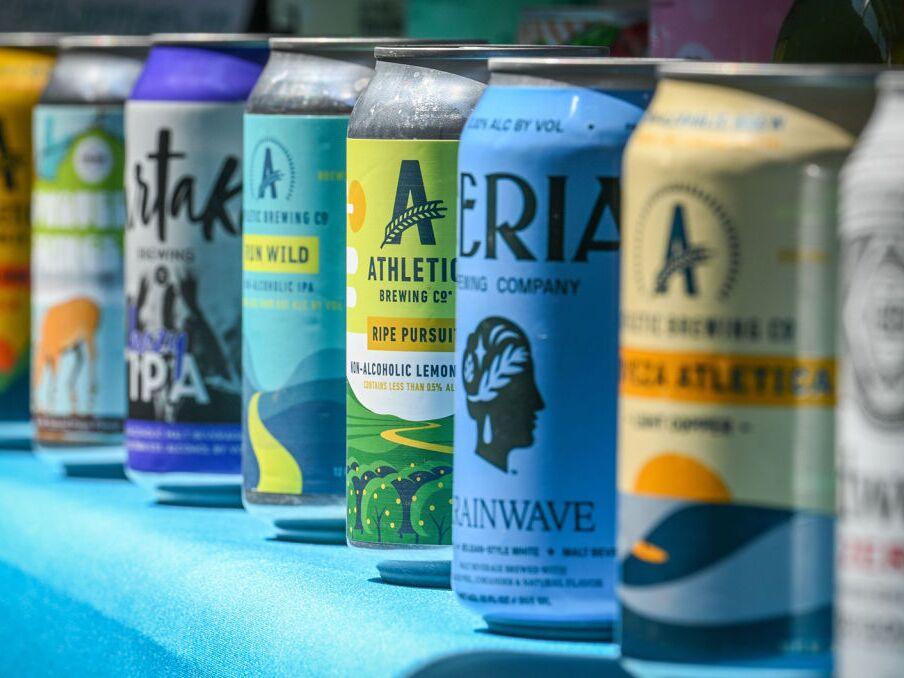Section Branding
Header Content
ID please. Should kids be able to buy nonalcoholic beer, wine and mocktails?
Primary Content
Darryl Collins owns a zero-proof bottle shop called Hopscotch in Baltimore, Md., selling over 200 options of nonalcoholic spirits, beer, wine and canned cocktails.
He opened the shop in August 2023 to get in on the booming market for adult nonalcoholic beverages. These are drinks with less than 0.5% alcohol by volume (ABV), marketed towards adults who want to cut back on drinking, avoid hangovers, or prevent other ill health effects from alcohol.
“Every day people are buying bottles of [non-alcoholic] wine – that is our top seller,” says Collins, “Outside of that, it's going to be what we call a ready-to-drink canned beverage, like canned cocktails.”
This emerging beverage category grew steadily in the past few years and received a major boost during the pandemic; it’s now worth upwards of $500 million a year in the U.S., according to the industry trade group Adult Non-Alcoholic Beverage Association.
Since these beverages contain virtually no alcohol, they can largely be sold to anyone, anywhere; they’re stocked on grocery and convenience store shelves around the country, and purchasable online. But Collins doesn’t sell to anybody under 18 years old at this store, and he checks ID’s to enforce that rule.
“When there’s no minimum age, can a nine-year old come into your store and buy a non-alcoholic Corona? For me, I don’t want that perception,” Collins says.
Collins set his own age limit, and he’s free to set it however he wants because in Maryland — as in the majority of states — there are no state age restrictions on who can buy adult non-alcoholic beverages.
Now, some health researchers are calling for clear, consistent age limits for non-alcoholic beers, wines and liquors, likening them to candy cigarettes.
“I think there is a risk that these could be an entry product for alcohol use,” says Molly Bowdring, a clinical psychologist and researcher at the Stanford Prevention Research Center, who co-authored a July 8 opinion piece in JAMA Pediatrics on the topic.
“There are so many cues in non-alcoholic beverages that mirror that alcoholic counterpart,” Bowdring says, like how they taste and smell, and provide the cultural experience of sipping from a koozied beer can or a fancy glass. “Additionally, a lot of full-strength alcohol producers are now making non-alcoholic products, so their brands are on these [non-alcoholic] beverages. That might lead to familiarity that then increases the likelihood of purchasing alcoholic products from that producer in the future,” she says.
To figure out which, if any, states limited the sale of adult non-alcoholic beverages, Bowdring called every state alcohol regulator and health department in the country, along with some food regulators. She found that 39 states had no statewide policies, and the states that did were inconsistent – Michigan, for instance, restricted the sale of non-alcoholic beer to those 18 and up, but had no such policies for non-alcoholic wines or liquors.
“A couple of entities emphasized that individual retailers are able to choose to ID if they want to, but that's really up to their discretion,” Bowdring says, “By and large, there are not restrictions on this. So this seems like a gap we want to fill sooner rather than later to get ahead of a potential public health issue.”
There’s no evidence so far that the boom in zero-proof beverages has led kids in the U.S. to drink alcohol, but Bowdring looks to the recent example of e-cigarettes as a cautionary tale. “Tobacco use was really declining among more recent generations,” she says, “And then there’s this huge marketing push for vaping, and then it led to an uptick.”
With non-alcoholic wine and liquor, Bowdring argues that there should be laws in place to get ahead of that. “If we leave the door open to there being a marketing push for non-alcoholic beverages among kids, could that then lead to increased alcohol use among this generation? We don't want to wait to find out if that's going to happen,” she says.
While Marcos Salazar, head of the Adult Non-Alcoholic Beverage Association, agrees that kids should not be drinking these products, he doesn’t think governments need to get involved. “We don’t want any regulation that’s going to have an impact on accessibility and cause additional resources to be spent for brands producing these products,” he says.
He notes that the widening availability of zero-proof adult drinks helps people who are trying to cut back on alcohol for their health.
Salazar says this emerging beverage industry can focus its marketing toward adults through advertising and store placement. “When you go into a retail shop or Whole Foods or Kroger and you see a set of these products, they're usually near the alcoholic beverages and [offered] as alternatives,” he says. “It’s very clear who they're marketed to and who they're for.”
And he points out that some sellers, like the chain store Target, already card for the purchase of these drinks. Collins, with the 18+ bottle shop in Maryland, concurs. As an industry, “we have to self-police, because if we don't self-police and self-regulate, that's when government regulates,” Collins says.

